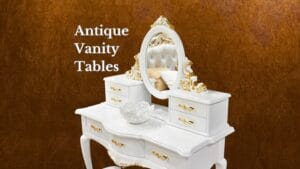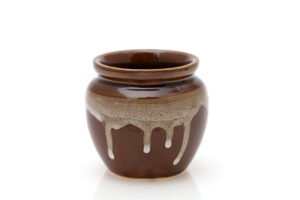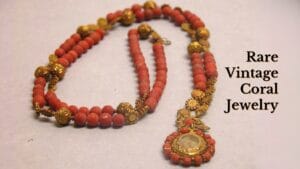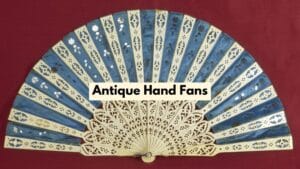Is your old vanity table gathering dust in the attic? It’s time you take it out and clean it because this piece of furniture could actually be worth thousands. Antique vanities display rare craftsmanship, making them a strong attraction for collectors, who are paying huge sums for rare examples.
So, if you want to spot a valuable vintage vanity worth a fortune, this guide will explain key steps to identify authentic examples along with crucial factors that impact an antique vanity table’s value.
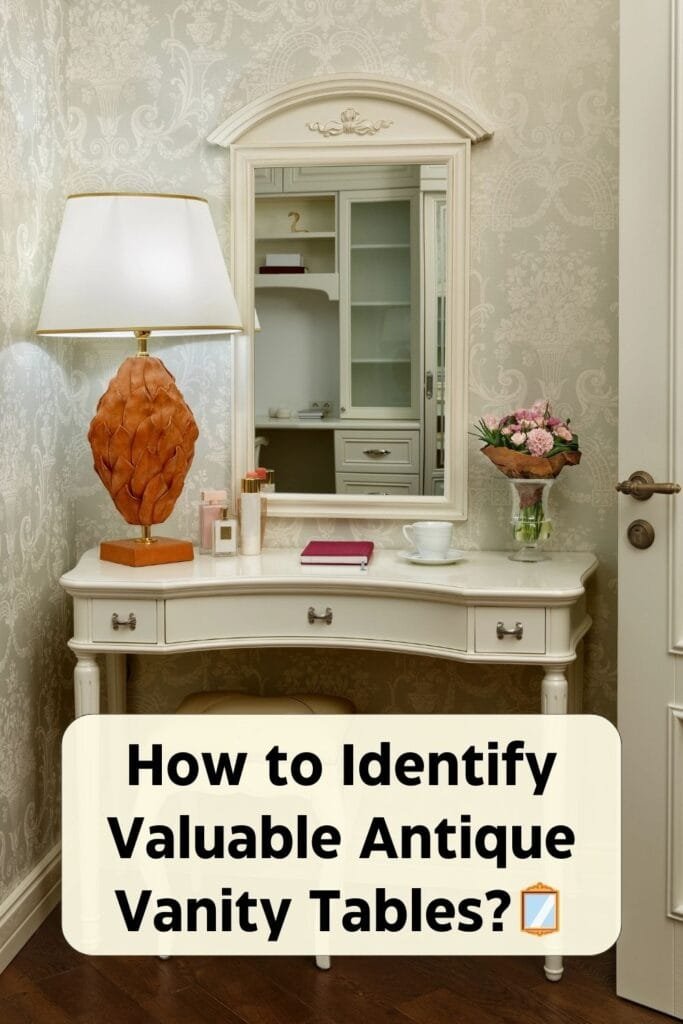
How to Identify an Antique Vanity? (4 Key Signs to Spot)
Vanity tables have existed for centuries. So, spotting an authentic antique vanity table demands a deep knowledge of different styles, materials, construction techniques, and many other details.
If you’re new to vintage furniture identification, here’s a breakdown of the 4 key aspects to identifying a valuable and genuine antique vanity table!
Design Styles & Materials
Since the early production of vanity tables, the. Identifying these design styles can offer a deeper insight into your piece’s age and history.
1. Victorian Vanity (c. 1830-1901)
Victorian vanity tables are the most ornate examples of rich materials and skilled craftsmanship.
- Materials: Victorian vanities typically feature expensive materials, such as exotic woods, including mahogany, rosewood, walnut, and marble for the top, with brass hardware. Even stools/chairs had luxurious upholstery fabrics such as silk, velvet, or brocade.
- Design Elements: The key design elements of Victorian vanities are their ornateness and embellishment. They feature large-scale tables with elaborate carvings inspired by nature and revival movements, like Gothic, Rococo, and Renaissance.
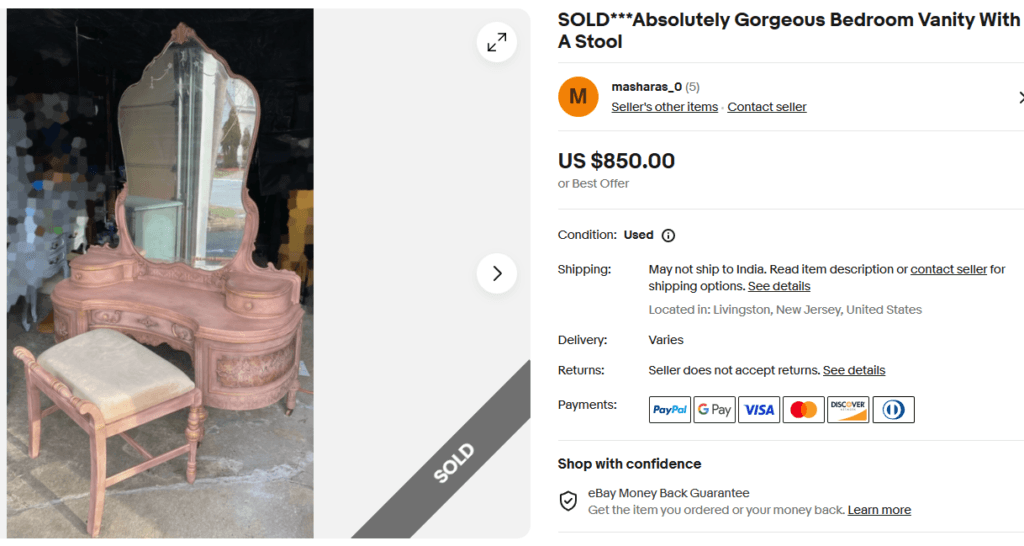
2. Edwardian Vanity (c. 1901-1910)
With slight similarities to the late Art Nouveau, the Edwardian style deviated from Victorian ornateness towards a lighter and refined look.
- Materials: Edwardian vanity tables were more practical and hence, featured lighter woods like walnut, satinwood, cherry, birch, and maple.
- Design Elements: The design on Edwardian-style vanities is simpler and cleaner, influenced by Neoclassical and nature-inspired Art Nouveau styles. Straight or angular lines were used, and even decorative motifs were made delicate and less elaborate. Turned legs and wing mirrors were common features of these vanities.
3. Art Nouveau Vanity (c. 1890-1914)
Art Nouveau vanities were inspired by natural forms and feminine elegance, offering a sleek yet ornate look.
- Materials: These vanities feature a wide range of materials. For instance, the structure was made with different types of woods, ranging from Mahogany, Walnut, and Oak to Ebony, Snakewood, Ash, and Poplar. Stained glass, ivory, gemstones, or seashells were used for decoration, and hardware was made of iron, steel, and particularly bronze.
- Design Elements: The Art Nouveau design mostly reflects natural forms, such as motifs of plants, flowers (like water lilies), vines, and insects (like butterflies). Flowing, curved lines and shapes are another defining characteristic. The hardware also features natural themes.
4. Art Deco Vanity (c. 1920s-1950s)
The Art Deco vanity table reflects exoticism, glam, and luxury, whether it’s via materials, design, or construction.
- Materials: Polished or lacquered exotic woods, such as Ebony, Macassar Ebony, Zebrawood, and Walnut, are common in Art Deco vanities. For hardware, chrome, steel, and Bakelite were used for a shiny look. Stained glass and mirrored surfaces added more to the Hollywood Regency appeal.
- Design Elements: Art Deco examples notably feature geometric patterns, such as zigzags, chevrons, sunbursts, and stepped forms. The early vanities tend toward bold colors, while later examples feature subtle, light shades. The ‘waterfall edge’ (rounded edge) is another defining feature.
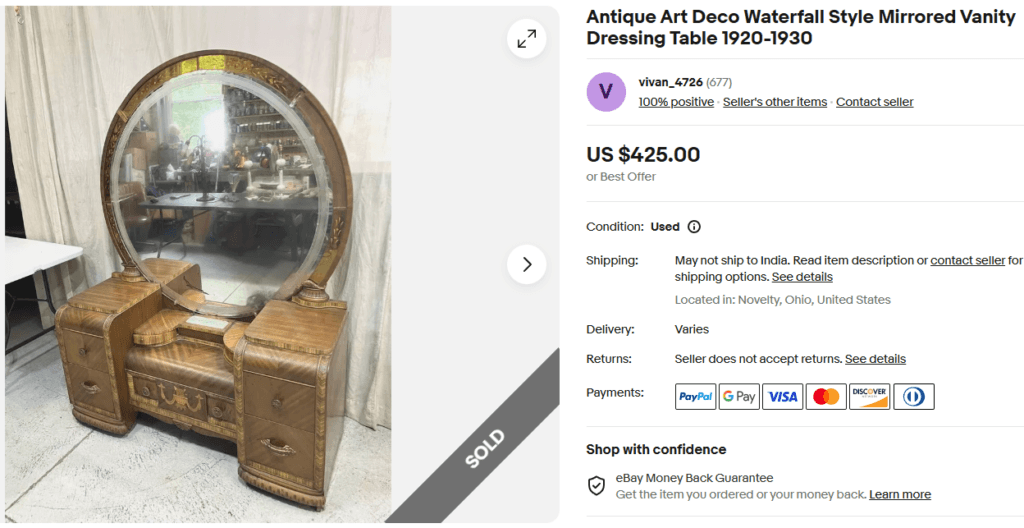
5. Mid-Century Modern (MCM) (c. 1940s-1970s)
The Mid Century Modern examples tend to be influenced by minimal and simplified elegance, featuring clean designs.
- Materials: Mid Century vanities focus on functionality, primarily using teak, mahogany, walnut, birch, Rubberwood, and oak for structure. The use of veneered plywood was also common. For hardware, aluminum, steel, brass, or copper were popular choices, along with glass and plastic/bakelite. Concrete, marble, or slate was used for tabletops.
- Design Elements: Clean and sleek lines with minimal ornateness and tapered legs are the defining features of the Mid-Century vanity tables. The carving often featured geometric and soft curves. The use of bold colors, like mustard yellow, teal, avocado green, or orange as accents is seen.
Manufacturer’s Marks
Truthfully, not all vintage furniture pieces are marked. However, if a maker’s mark is present, it can be a significant tool to identify the vanity table’s manufacturer, origin, and manufacturing period.
Generally, marks are added in hidden areas so as not to disturb the piece’s aesthetics. You’ll mostly find them on the underside of the piece, inside the drawers, underneath the tabletop or frame, back panels, and legs.
Generally, there are the following types of marks found on antique vanities:
- Carved, Branded, or Stamped Marks: These marks are directly impressed into the wood via carving or hot iron. For example, French furniture made after 1743 often bears guild stamps (JME – Jurande des Menuisiers-Ébénistes).
- Ink Stamps: These types of marks are commonly found on the 19th and early 20th century pieces, especially for prominent manufacturers. These stamps often include the company’s name, location, or serial number.
- Ivorine Labels: These are thin, ivory-like plastic labels featuring engraved or printed details. These are mostly found on the late 19th and early 20th century examples.
- Embossed Metal Tags: These are brass or copper tags featuring raised lettering with the company’s name and location attached to the piece with small nails or rivets.
- Paper Labels: Paper labels displaying the maker’s name and address are glued to the piece. These can be handwritten or printed.
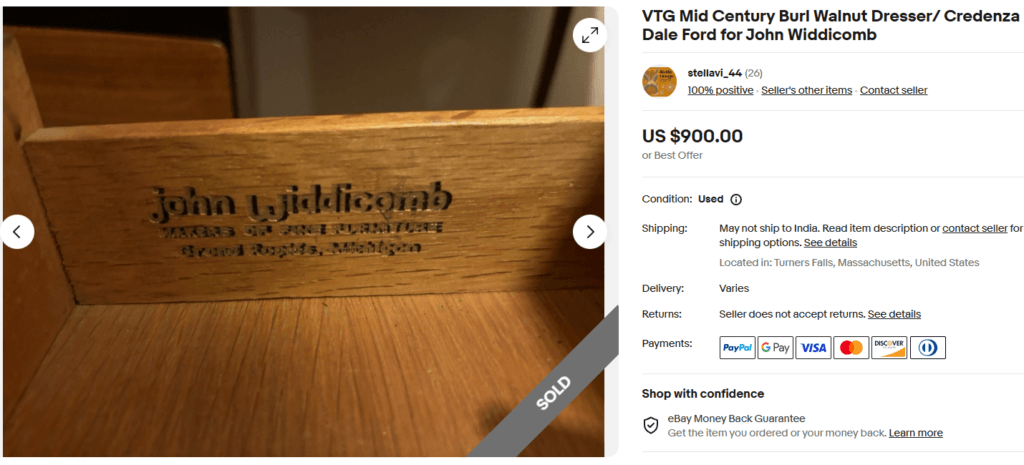
Note: The numbers included in the marks may indicate different information, such as the patent number or style number.
Construction Signs
The construction techniques used to make a vanity dressing table can offer significant details about its age and style. Here’s how:
Tool Marks:
Tool marks on a piece, indicating how the wood was made, will be either handmade tool marks or machine-made marks. Handmade tool marks are often irregular with nicks or shallow cuts on surfaces, indicating that hand tools like planes, spokeshaves, or drawknives were used.
On the other hand, machine-made marks are uniform and clean. Evenly flat surfaces and the presence of circular or arc-shaped marks generally hint at the machine-made construction.
Fasteners:
While generally overlooked, the types of fasteners used on an old vanity dressing table can actually help date it. Here’s how:
Before the mid-19th century, handmade screws were used to tie the piece together. These screws typically feature irregular threads and uneven or slightly off-center slots. In later period, machine-made screws were used, which are quite uniform and polished.
Similarly, if a vanity table has square-cut nails (often handmade or machine-cut), it was likely made before the 1880s. Round wire nails became prevalent afterwards.
Surface Finish
The type of finish displayed on a vanity dresser can also indicate its age. Here’s how:
- Shellac Finish: This is a clear finish which was predominantly used before the mid-1880s.
- Lacquer and Varnish: These shiny and polished finishes were common in the post-1860 era.
- Oil, Wax, or Milk Paint Finishes: These finishes are seen in very early examples.
Collector’s Tip: The shellac finish dissolves with denatured alcohol. Similarly, milk paints react to ammonia.
What Makes an Antique or Vintage Vanity Valuable?
Antique vanities can be valued from $500 to $20,000 or more today! However, not every old vanity table or cabinet will be valuable; only those with certain signs and characteristics will fetch some money. What are those features? Let’s find out!
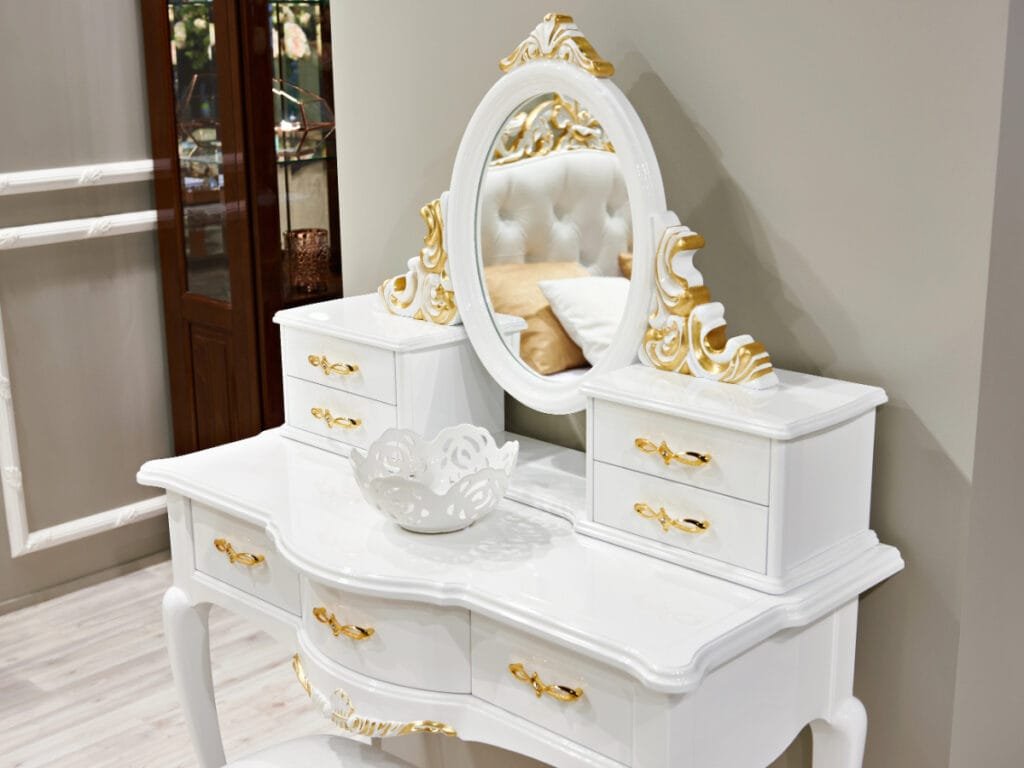
Condition & Functionality
When it comes to furniture items, like a vanity table, the condition is the most vital factor to influence its value. Naturally, well-preserved vanities in pristine or near-original condition typically command high premiums.
Damages like cracks, deep scratches, water stains, paint chips, a missing or broken/chipped/cracked mirror, rusty or missing hardware, or a loose structure can seriously lower the worth of an antique vanity table.
However, damages like minor wear and a natural patina developed over time are signs of aging and won’t detract from that value. In fact, some collectors value these signs even more. Also, if the vanity stool has original upholstery, it will add to the overall value.
Lastly, vanities that are fully functional with intact mirrors, smooth drawers, and stable frames are highly desirable and valuable.
Rarity
The rarer a vanity dressing table, the higher premiums it will fetch. In the case of vanities, the rarity can depend on several aspects. For instance, unique or limited production models are considered rare and worth more. Regional or cultural uniqueness, such as French provincial vs. American Victorian style, can also affect the demand and worth.
Secondly, vanities in unusual shapes and colors or custom-designed pieces can be rare and desirable. Similarly, a less common style from a given period can be rather rare.
Examples designed by sought-after designers or manufacturers with limited output are generally difficult to find and, hence, command larger sums.
Also, certain styles are considered rarer due to their age. For example, antique Victorian vanities are the oldest and, hence, finding one in good condition is rather difficult. So, these tables can sell for up to $15,000, like this example sold for over $13,000 on Etsy!
Materials and Construction
The type of material used to make a vanity table significantly impacts its value. For example, vanities made of premium materials like solid hardwoods (mahogany, walnut, oak, rosewood) and exotic veneers are generally more valuable than those made of low-quality wood.
Also, a table with exotic materials, like marble, as the tabletop and ivory accents also fetches higher returns. Similarly, high-quality original hand-forged hardware made of brass and bronze enhances more value than steel or aluminum hardware.
Moreover, the construction and craftsmanship of the vanity also influence its final value. For instance, premium craftsmanship reflected by ornate hand-carving, fine joinery (like hand-cut dovetails or mortise-and-tenon joints), and flawless finishing makes the vanity all the more valuable.
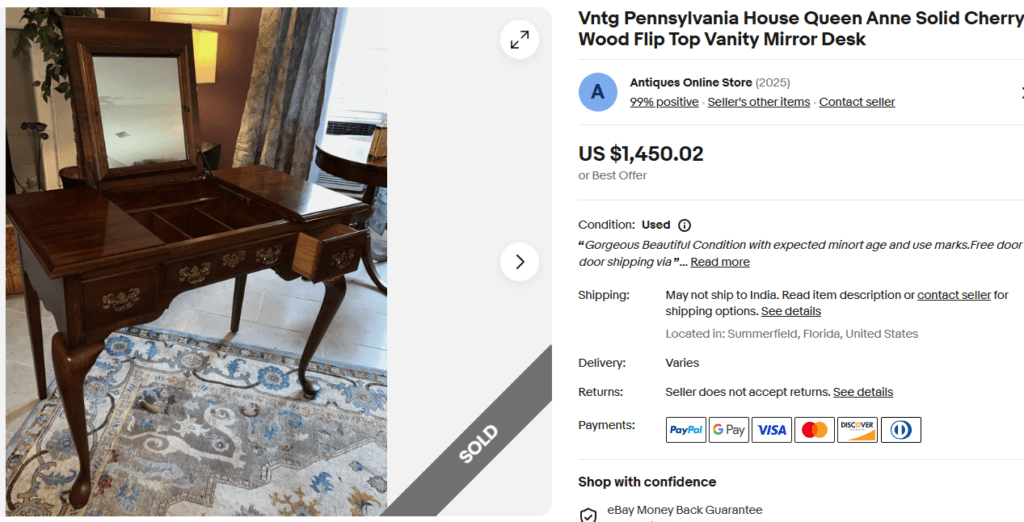
Maker/Designer
Naturally, antique vanity tables manufactured by well-known furniture makers, such as Drexel, Bassett, Berkey & Gay, Kindel, and Widdicomb, are typically more desired by collectors.
Similarly, vanity pieces designed by popular designers typically carry a premium. For instance, a documented table made by famous artists, like Chippendale, Ruhlmann, or Eames (if they designed vanities) would be significantly more valuable than an anonymous example of similar style and age.
Size and Completeness
Needless to say, the size of a vanity directly impacts its value; the larger the table, the more valuable it will be. Also, if the vanity was made as a set with a matching stool/chair, the presence of that stool with its original upholstery will further add to the value.
For example, a complete set of an antique vanity table and stool can be 15% to 30% more valuable compared to the vanity table sold alone.
Note: This article is intended for informational, educational, and entertainment purposes only. Some images are illustrative and may not represent actual brands, products, or related entities. All trademarks, product names, brand logos, packaging, and other intellectual property referenced remain the exclusive property of their respective owners. Any brand mentions or references are provided solely for descriptive and educational context and do not imply any formal or commercial association.

